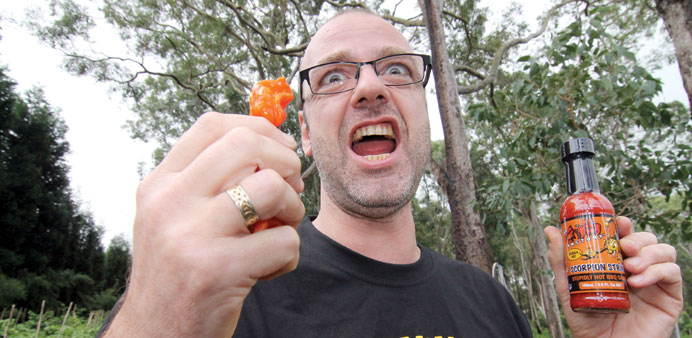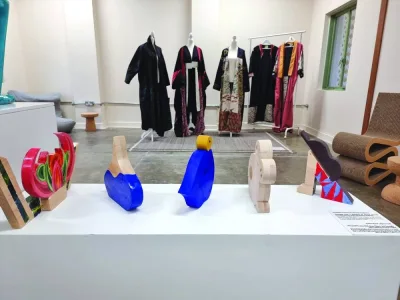Ron Bruns with a pie and peppers from his Bremen Patisserie, a magnet for hot food lovers in Australia. Photographs: Sid Astbury
By Sid Astbury
Customers at Ron Bruns’ Bremen Patisserie at Umina Beach, north of Sydney, tuck into what the German-born pastry chef claims is the hottest meat pie on the planet. They first have to sign a waiver saying they accept that the fiery chilli peppers in the Flaming Ron could trigger a heart attack. “It’s really extraordinary,” he said. “There was a woman in. It took her six minutes. She was flaming. In pain. It’s amazing what they go through.”
Another 400km up the coast, Margaret Schumacher is ordering in the chilli jam, chilli chocolate, chilli cakes and even chilli wine for July’s Chilli Festival at Sawtell.
She is expecting 12,000 visitors this year and, as usual, has failed to entice the Red Hot Chilli Peppers to headline the show bands.
“Once it was just meat and three vegetables,” she said of Australia’s cuisine. “Chilli wasn’t an ingredient we used when we were growing up. But now everyone’s using it.”
What links Bruns and Schumacher is the Dutch-born de Wits, a family of capsicum fanatics in Morisset, 110km north of Sydney. They hold the Guinness World Record for the hottest chillies ever grown and have helped Bruns and Schumacher in their quest to put the blowtorch to traditionally bland food.
Their Chilli Factory sauces with scary names like Morning Afterburn, Fiery Frillneck Hiss and Scorpion Strike are putting hellfire into what the locals eat.
The de Wit’s golf-ball-sized Trinidad Scorpion Butch T measures a mighty 1,463,700 Scoville heat units. That compares with 30,000 units for Tabasco sauce and just 2,750 units for jalapenos.
“People are getting more accustomed to chillis and they want them hotter and hotter,” Alex de Wit said. “When we started 13 years ago it was 60% mild and 40% hot, but it’s 65% hot now.”
Bruns has applied for the Guinness accolade for his Flaming Ron, which measures 200,650 on the Scoville scale.
Business is booming as the fad for fiery food spreads.
The de Wits struggle to meet orders for relishes made from the 103 varieties of peppers they grow. Schumacher puts the new taste for piquancy down to Asian holidays that introduce Australians to spicy food. “As well as more people travelling, and chillies being so easy to grow, there are the cooking shows and seeing how you can use them in your cooking,” she said.
Chillies also bear the seeds of addiction, according to de Wit, who gave up the computer industry for a career in horticulture. “It’s a natural addiction,” he said. “When you eat chilli you get an endorphin rush like with running. It’s the same trigger. It makes you feel happy so you want more. But it will never be as hot as the first time.”
Sydney University researcher Mark Peacock, who helped the de Wits get recognition for the hottest chillies, is a myth-buster when he talks about his postgraduate studies of the Capsicum annuum species.
Red ones are not hotter than green ones and big ones are not hotter than small ones. It is not true they grow better in an arid climate than in a humid one.
Peacock reckons the strip of coast, north of Sydney, might have the perfect climate for growing them. And another fallacy: it is not the seeds that are the hottest part but the placenta, the strand of white flesh left when the seeds are tripped out.
The good news for heat freaks is that natural selection will ensure that the Trinidad Scorpion Butch T, one of around 1,200 strains of the capsicum family, will be challenged for top-dog status as other stains reach their full genetic potential.
“The hotter chillies are, the more likely they are to survive,” Peacock said. “But this process of evolution of hotter varieties takes hundreds of years.”
De Wit is convinced that there are more Scoville units to be had from the plants in his patch of dirt. “There are rumours out there that if you’re mean to the plant, give it less water, you get a hotter chilli but that’s not true,” he said. “We found that if you treat them really, really well the chillies are hotter.”
Dr Peacock agrees that feeding urine collected in a worm farm is helping the de Wits stay ahead of the bunch. “Really healthy soils often contain the right chemistry to support optimal growth but this can certainly be supplemented by using worm juice,” he said.
The worm effluent contains the remains of dead insects and triggers mechanisms in the chilli plant to defend itself from a perceived pest attack. — DPA



